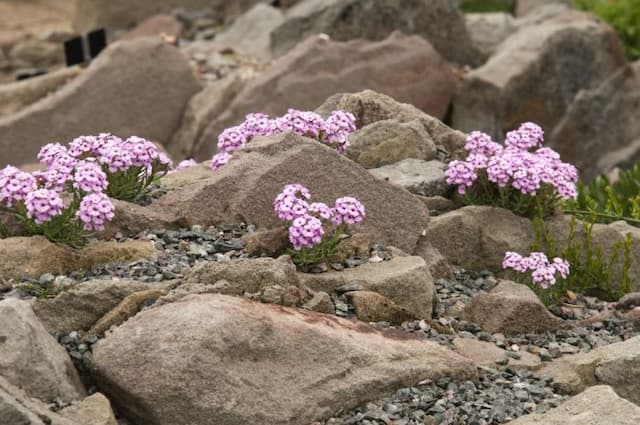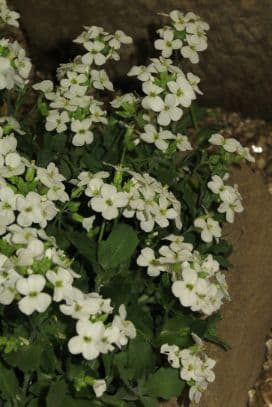Rock Cress Aubrieta 'Doctor Mules'

ABOUT
Aubrieta 'Doctor Mules', commonly known as false rock cress, is a vibrant, mat-forming perennial that boasts a dense carpet of small leaves. These leaves are oval-shaped with a slightly hairy texture, and they typically exhibit a rich green hue that persists throughout the growing season. In the spring, this plant comes alive with a profusion of small, four-petaled flowers, which cover the foliage in a blanket of color. The flowers of the 'Doctor Mules' variety display a striking purple shade, with each bloom creating a dazzling contrast against the verdant leaves. False rock cress is often lauded for its vigorous growth and its ability to cascade gracefully over rocks and walls, making it an ideal choice for rock gardens or as ground cover in landscape designs. The overall impression of Aubrieta 'Doctor Mules' is that of a lush and colorful tapestry, which adds both visual interest and a touch of nature's splendor to any garden space.
About this plant
 Names
NamesFamily
Brassicaceae
Synonyms
Rock Cress, False Rockcress, Purple Rock Cress, Rainbow Rock Cress
Common names
Aubrieta 'Doctor Mules'
 Toxicity
ToxicityTo humans
Aubrieta, commonly known as rock cress, is not generally considered to be toxic to humans. Ingesting parts of the plant is unlikely to be harmful, and there are no well-documented cases of poisoning from Aubrieta to suggest otherwise. However, as with any plant, individual sensitivity can vary, so it is advisable to exercise caution and not consume parts of the plant not meant for human consumption.
To pets
Rock cress is not known to be toxic to pets. There have been no significant reports of poisoning in pets such as cats and dogs from consuming this plant. Nevertheless, it's always a good practice to keep an eye on your pets and prevent them from eating large amounts of any non-food plants, as these could potentially cause gastrointestinal upset or other individual reactions.
 Characteristics
CharacteristicsLife cycle
Perennials
Foliage type
Semi-evergreen
Color of leaves
Green
Flower color
Purple
Height
6 inches (15 cm)
Spread
18 inches (45 cm)
Plant type
Herb
Hardiness zones
4
Native area
Southern Europe
Benefits
 General Benefits
General Benefits- Low Maintenance - Aubrieta is known for being easy to care for, requiring minimal attention once established.
- Drought Tolerant - It can survive with little water, making it suitable for dry climates.
- Ground Cover - Its spreading habit makes it excellent for covering bare spots in the garden.
- Erosion Control - Aubrieta can help prevent soil erosion on slopes and banks.
- Attracts Pollinators - The plant's flowers attract bees and butterflies, promoting pollination in the garden.
- Spring Blooms - It produces vibrant flowers in the spring, adding color to the landscape after a dull winter.
- Rock Gardens - Perfect for rock gardens due to its ability to grow in rocky, less fertile soils.
- Edging Plant - Can be used effectively as edging along paths and garden borders.
- Evergreen - Many varieties remain green throughout the year, providing a constant touch of greenery.
 Medical Properties
Medical PropertiesThis plant is not used for medical purposes.
 Air-purifying Qualities
Air-purifying QualitiesThis plant is not specifically known for air purifying qualities.
 Other Uses
Other Uses- Aubrieta can be used in green roofing, providing not only aesthetic benefits but also contributing to better insulation and biodiversity.
- In photography and painting, the vibrant hues of Aubrieta can serve as an inspiring subject or a rich backdrop for creative works.
- Due to its cascading habit, Aubrieta works well in creating living curtains or drapes when grown in vertical gardens or on trellises.
- Aubrieta serves as an indicator plant in gardens, as its health can reflect the overall condition of the garden ecosystem, such as soil quality and pH balance.
- As part of sensory gardens, the plant's texture and color can be used to stimulate visual interest and contribute to a therapeutic environment.
- When dried, the foliage and flowers of Aubrieta can be used in potpourri mixtures to provide a natural and subtle fragrance indoors.
- During outdoor festive occasions, Aubrieta can be used as a living decoration to outline pathways or decorate tables due to its low profile and dense mat-forming growth.
- In crafting, the small flowers of Aubrieta can be pressed and used in making bookmarks, greeting cards, or other paper-based crafts.
- Aubrieta can be used in educational settings such as schools or botanical gardens to teach students about plant growth, pollination, and alpine flora.
- Eco-friendly confetti can be made from the petals of Aubrieta flowers, providing a biodegradable option for celebrations.
Interesting Facts
 Feng Shui
Feng ShuiThe plant Aubrieta is not used in Feng Shui practice.
 Zodiac Sign Compitability
Zodiac Sign CompitabilityThe plant Aubrieta is not used in astrology practice.
 Plant Symbolism
Plant Symbolism- Resilience and Survival: Aubrieta, also commonly known as Rock Cress, is known for its ability to survive in tough conditions, often found on rocky slopes and crevices. This symbolizes the ability to thrive in difficult situations and to survive against the odds.
- Beauty and Simplicity: With its small yet vibrant flowers, Rock Cress represents the notion that beauty can be found in simple, humble places. It reminds us that there is elegance in simplicity.
- Grounding: As a ground-covering plant, Rock Cress symbolizes staying grounded and connected to one's roots. It suggests a sense of stability and reminds us of the importance of being humble and down-to-earth.
- Overcoming Challenges: The plant's hardiness and ability to grow in challenging environments make it a symbol of overcoming obstacles. It represents perseverance and determination to grow no matter the circumstance.
 Water
WaterWater the false rock cress only when the top inch of the soil feels dry to the touch since it's drought-tolerant and doesn't require frequent watering. During the growing season, watering once a week with approximately 1 gallon of water per square yard should suffice. Reduce the watering frequency in the fall and winter when the plant is dormant. Be sure to water the plant at the base and avoid wetting the foliage, as this can promote disease. False rock cress prefers consistent moisture but will suffer in waterlogged soil, so ensure good drainage.
 Light
LightFalse rock cress thrives best in full sun to partial shade. The ideal location would be a spot that receives at least 6 hours of sunlight each day. Avoid deeply shaded areas since insufficient light can hinder blooming and weaken the plant.
 Temperature
TemperatureFalse rock cress is hardy and can withstand temperature extremes from as low as 20 degrees Fahrenheit during dormancy to as high as 85 degrees Fahrenheit during active growth. The ideal temperature range for this perennial is between 60 and 75 degrees Fahrenheit, which promotes healthy growth and blooming.
 Pruning
PruningFalse rock cress should be pruned after flowering to promote a compact growth habit and prevent it from becoming leggy. Trimming back by about a third immediately after blooming will encourage denser foliage and possibly a second, lighter bloom. Pruning is typically done annually or biannually depending on the plant's performance and desired appearance.
 Cleaning
CleaningAs needed
 Soil
SoilThe best soil mix for the plant commonly known as Rock Cress should be light, well-draining, and preferably alkaline in nature with pH between 6.5 and 7.5. A combination of loamy or sandy soil enriched with compost or other organic matter will promote healthy growth.
 Repotting
RepottingRock Cress rarely needs repotting as it is a low-growing perennial that spreads across the ground. Typically, it is not repotted unless the plant has outgrown its space or the soil needs replenishment, which may occur every 2-3 years.
 Humidity & Misting
Humidity & MistingRock Cress prefers a drier climate and does well in average to low humidity environments. It is tolerant of drought conditions once established and does not require high humidity levels to thrive.
 Suitable locations
Suitable locationsIndoor
Provide bright light and good air circulation indoors for Rock Cress.
Outdoor
Plant in sunny spot with well-draining soil; tolerate drought once established.
Hardiness zone
4-9 USDA
 Life cycle
Life cycleThe Aubrieta 'Doctor Mules', commonly known as False Rockcress, begins its life cycle with seed germination, occurring mainly in spring or autumn in well-draining soil with some warmth. Following germination, seedlings establish and develop a deep taproot and rosettes of small, green leaves. As the plant matures, typically in the second year, it enters its vegetative stage, forming mats of evergreen foliage. The flowering stage occurs in early spring when the plant produces masses of small, vivid purple flowers that attract pollinators, helping set seed for the next generation. Once the flowering is complete, the plant produces seed capsules, which when mature, release seeds, completing the reproductive cycle. Between flowering seasons, the plant enters a period of dormancy, especially in colder climates, where it conserves energy and prepares for the subsequent year’s growth.
 Propogation
PropogationPropogation time
Spring-Early Summer
Aubrieta 'Doctor Mules', commonly known as purple rock cress, is most popularly propagated through cuttings. This method is typically undertaken in late spring or early summer when the plant has fresh, non-flowering shoots. You begin by selecting a healthy, non-woody stem and cutting a length of 4 to 6 inches (10 to 15 centimeters), just below a leaf node. The lower leaves are then removed, and the cut end may be dipped in rooting hormone to encourage root growth, though this is not strictly necessary. The cutting is then planted in a well-draining soil mix, with the remaining leaves just above the soil surface. It should be kept moist but not waterlogged, and within a few weeks, the cutting should root and gradually establish itself as a new plant.



![Aubrieta [Axcent Light Blue]](/_next/image?url=https%3A%2F%2Fplants-admin.emdemapps.com%2Fimages%2Fplants%2F%2Fimages%2F604b5e7128866.png&w=640&q=75)





